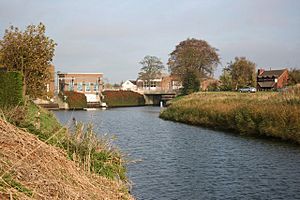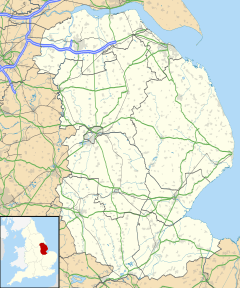Deeping Fen facts for kids
Quick facts for kids Deeping Fen |
|
|---|---|
 The electric pumping station at Pode Hole, known as the Adventurers pumping station |
|
 Bylaws posted on the old pump station |
|
| Population | 1,961 |
| OS grid reference | TF215160 |
| • London | 85 mi (137 km) S |
| Civil parish |
|
| District | |
| Shire county | |
| Region | |
| Country | England |
| Sovereign state | United Kingdom |
| Postcode district | PE6 |
| EU Parliament | East Midlands |
| UK Parliament |
|
Deeping Fen is a flat, low-lying area in Lincolnshire, England. It covers about 47 square miles (120 square kilometers). The area is surrounded by the River Welland and the River Glen.
Because it's so low, Deeping Fen needs a lot of help to drain water away. For hundreds of years, smart engineers worked on ways to keep the land from flooding. They faced a big challenge because the rivers didn't flow low enough to drain the fen naturally. Many plans involved making the rivers better.
In the 1600s, a group called the "Adventurers" took charge of the drainage. They were given land in return for their work. Later, engineers like John Perry and John Grundy, Sr. and Jr., used new ideas to improve the drainage. They were pioneers in using scientific methods for engineering problems.
By the 1800s, engineers like William Jessop and John Rennie suggested using steam power. In 1823, two steam engines with giant scoop wheels were installed at Pode Hole. This was the biggest pumping station in the Fens for a long time. Over the years, steam engines were replaced by diesel engines, and scoop wheels by modern centrifugal pumps. Today, electric motors do the work. You can still visit an old beam engine and scoop wheel at Pinchbeck Marsh, which worked until 1952!
Since 1801, the fen has been managed by special groups. Today, it's looked after by the Welland & Deepings Internal Drainage Board. They make sure the water levels are controlled.
Contents
Where is Deeping Fen?
Deeping Fen is a flat area of land between the River Welland and the River Glen. These two rivers meet at the northern end of the fen. The area is about 47 square miles (120 square kilometers) in size.
Originally, Deeping Fen was considered "waste land." It didn't belong to any specific parish and was free from land taxes. This was because it was reclaimed by the "Adventurers" who drained it. In 1846, about half of the fen became the parish of Deeping St Nicholas.
The name "Deeping" comes from an old English word meaning "deep or low place." The village was even mentioned in the Domesday Book in 1086. This was a big survey of England ordered by William the Conqueror.
How Deeping Fen Was Drained
For centuries, people living near the River Welland wanted the fens to be drained. In the late 1500s, they asked Queen Elizabeth I for help. Thomas Lovell took on the job, spending £12,000. In return, he received 15,000 acres (6,100 hectares) of the newly drained land.
However, some of the drainage works were later destroyed. In 1632, a new group of "Adventurers" got permission to drain Deeping Fen. This group was led by the Earl of Bedford. Their work included making the River Welland deeper and wider. They also built side drains, like Vernatt's Drain, named after one of the Adventurers, Sir Philibert Vernatti. Even with these efforts, the fen wasn't fully drained until the Pode Hole pumping station was built much later, in 1827.
In 1664, another attempt was made to drain the fen. The Earl of Manchester and others were given 10,000 acres (4,000 hectares) for their work. They also had to maintain the river banks. But bad weather and problems with the river's exit to the sea made it hard to finish the job.
Smart Engineering Ideas
In 1729, Captain John Perry suggested a new idea. He believed the only way to improve drainage was to fix the river exits. He proposed building special gates called "scouring sluices" at different points. These sluices would release water at low tide to clean out mud from the riverbed. Perry was a well-known engineer. He started work in 1730.
One of his sluices on the Welland had six gates, each 6 feet (1.8 meters) wide. These gates were opened by chains connected to a large treadwheel. At high tide, water was held back. At low tide, the gates opened, and the rushing water cleaned the river. Perry died in 1733 before all his projects were finished.
John Grundy, Sr. took over after Perry. He believed in using math and science for drainage. In 1733, he used a special telescope-like tool to measure land levels very accurately. He also studied how water flowed in drains. He found that water didn't flow as fast as math predicted because of friction. He published his findings in 1734.
Grundy insisted that accurate maps and careful observation were key to draining fenland. He worked for the Adventurers of Deeping Fen. He mapped 22 miles (35 kilometers) of the Welland. His main idea was to build a reservoir and sluice at the mouth of the River Glen. This would store water to clean the channel at low tide.
In 1738, a plan by Grundy and Humphry Smith was approved by Parliament. They repaired the Deeping Bank, which protected the fen from the Welland. Grundy also made the Welland deeper and wider. He built a sluice and an 8-acre (3.2-hectare) reservoir at the Glen's mouth. Two drainage mills with 16-foot (4.9-meter) scoop wheels were also built. Grundy died in 1748, known for using scientific methods in engineering.
More Engineers and Steam Power
John Grundy, Jr. continued his father's work in 1748. He spent a lot of money repairing the banks. He rebuilt Perry's sluice on the Welland, adding taller doors and tide gates to stop the tide from flowing upstream. He also built more drainage mills.
In 1798, the fen flooded badly. Engineers William Jessop and John Rennie were called in. They realized that the river exits were too high for water to drain by gravity. They suggested using steam pumping engines at Pode Hole. These engines would pump water from the fen's inner drains into Vernatt's Drain. This would lower the water levels inside the fen, helping the existing wind-powered mills work better.
Their report led to the Deeping Fen Act of 1801. The Welland was made deeper, and its banks were strengthened. The North and South Drove Drains, which crossed the fen, were also made deeper. At this time, there were no steam engines working in the Fens, so Rennie's idea for a steam pumping station wasn't built right away.
The Age of Pumping Stations
Finally, in 1823, the use of steam engines was approved. Two large beam engines were ordered. The bigger one, called the Holland engine, was 60 horsepower. It drove a huge 28-foot (8.5-meter) diameter scoop wheel with 40 scoops. This wheel lifted water by 5 feet (1.5 meters). The smaller Kesteven engine, 80 horsepower, drove a similar scoop wheel.
These engines started working in 1825 and cost £26,673. The Pode Hole pumping station was the biggest in the Fens and stayed that way for many years.
Over time, the pumping station was updated. In the early 1900s, two 100-horsepower diesel engines were added to help the steam engines. These were removed in 1956. Later, a 250-horsepower diesel engine was installed.
The first electric pump was added in 1939. Three more electric pumps followed in 1957. In 1964, a new engine house was built. It held two powerful 650-horsepower Ruston diesel engines and a third 410-horsepower Ruston unit. These drove large Gwynnes Limited pumps.
Other Drained Areas
Pinchbeck South Fen, an area of 1,700 acres (690 hectares), is west of Vernatt's Drain. In 1828, its residents wanted to use the Pode Hole pumps. They built their own pumping engine in 1830, a beam engine with a 20-foot (6.1-meter) scoop wheel. This cost £3,000, much less than what the main trustees wanted to charge them. This engine was replaced over the years by diesel and then electric pumps.
Pinchbeck Marsh was also part of Deeping Fen. In 1832, it became a separate district called the Spalding and Pinchbeck District. A 20-horsepower Butterley beam engine with a 22-foot (6.7-meter) scoop wheel was installed in 1833. This engine and wheel worked until 1952, making it the last and longest-running beam engine in the Fens! You can still visit this historic plant today.
The management of Deeping Fen changed over time. In 1939, the original trustees were replaced by the Deeping Fen, Spalding and Pinchbeck Internal Drainage Board. This board later joined with others in 1973 to form the Welland & Deepings Internal Drainage Board, which manages the water today.
Images for kids




